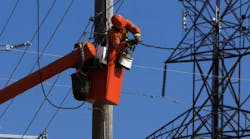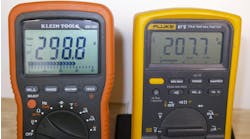Avoiding Contact with Energized Electrical Conductors
Whether you're a licensed electrical contractor, a recent trade school graduate, or a seasoned electrical worker, believe me when I say you do not want to deal with the consequences of an electrical contact. I became one of those industry statistics you read about some years ago, after coming in contact with a 7,620V phase-to-ground power distribution line and blowing out a 140A fuse. Although I did not walk away from the accident unscathed, I was lucky enough to survive, after being taken by medevac to Crozer-Chester Medical Center (a regional burn center in the Philadelphia area) to recover from second- and third-degree burns to more than 20% of my body. It was there that I learned how complacency, overconfidence, and lack of focus can forever alter your life.
Increased risk of injury can stem from so many different factors — from complacency due to tenure on the job or an eagerness to show your skills to a new boss to a lack of focus because you have family issues on your mind or the fact that you're exhausted from watching a late-night sporting event the night before. No matter what the reason is, failure to follow some critical guidelines resulted in 19,260 electrical contact injuries (not including lightning strikes) in various industry categories and 360 deaths in 2005, according to data compiled by the U.S. Bureau of Labor Statistics.
Despite these sobering statistics, you can prevent a contact injury by reviewing and practicing some well-known safety tips and techniques. Taking the time to be your own safety advocate might just be the difference from going home at the end of the day to your loved ones and becoming one of those statistics you think will never happen to you.
Barriers
The most common way to prevent a path to ground when contacting an energized conductor, barriers may be as simple as wearing an appropriate pair of voltage-rated rubber gloves, which isolate you from contacting the live conductor, or dielectric boots, which eliminate a path to ground.
Dig safe
Take advantage of the national Dig Safe program, which allows tradespersons and residential property owners to call “811” and have underground utility lines marked before they perform any type of excavation. Before providing an estimate for a job, contact the local utility to determine if there are charges involved with making the area around the job site safe. It's better to know of these up front, so you can factor these costs into your calculations. Some approaches you can take to make the site safe include, but are not limited to:
-
Removal of conductors in the immediate area of work.
-
De-energizing and grounding conductors in the work area.
-
Temporarily re-routing the electrical circuit while the job is being carried out.
-
Installing flags or tell-tale markers to indicate the presence of overhead energized electrical conductors.
-
Installing an insulated barrier on the conductor to minimize the effect of an incidental contact. Caution: This is an extra precaution but does not minimize the distance an unqualified worker must maintain from the energized conductor (See OSHA 1910.333 below).
Remember the 10-ft circle of safety
Most electric utility companies have programs set up in their respective service areas that address overhead conductors. Each will take various approaches to provide a safe work environment for the contractor and general public. However, it's ultimately the responsibility of your company and your workers to ensure that you maintain a safe distance from overhead energized conductors — especially if non-qualified electrical workers are involved.
The guideline you must follow is often referred to as the “10-ft circle of safety” rule. A careful review of the Occupational Safety and Health Administration (OSHA) regulation clearly identifies the distance you must maintain while performing work near overhead power lines.
“1910.333(c)(3)(i)(A) — When an unqualified person is working in an elevated position near overhead lines, the location shall be such that the person and the longest conductive object he or she may contact cannot come closer to any unguarded, energized overhead line than the following distances:
(1) — For voltages to ground, 50kV or below: 10 ft (305 cm);
(2) — For voltages to ground over 50kV: 10 ft (305 cm) plus 4 in. (10 cm) for every 10kV over 50kV.”
The power of step potential
Step potential is similar to ripples created in a pond. If an energized conductor is lying on the ground, it is injecting current into the soil. The voltage levels surrounding this conductor can also be compared to the ripple effect created in a pond when you throw a stone into the water. The voltage levels decrease as you move away from the point where the conductor touches the ground.
If you were to take a step toward or away from the energized conductor, the difference in voltage between one foot and the other is called step potential. Step potential levels can be fatal, so it's imperative that you stay at least 30 ft away from any downed energized conductor.
What happens when a storm topples power lines, or a vehicle hits a pole and the overhead lines are dropped to the ground? Do you step out of the vehicle? Do you run over to the driver's side of the vehicle to determine if the driver is okay? If you ever find yourself in this situation, follow these guidelines:
-
If you are in the vehicle, staying there is your safest option until help arrives.
-
If you can safely move the equipment away from the power lines, do so cautiously. If you are unable to do so, do not move until the conductors can be de-energized.
-
If you must exit the equipment because of fire or other life-threatening concerns, jump free of the equipment. Never step down and touch the ground and the equipment at the same time.
-
If the overhead line has fallen on the ground or a piece of equipment, assume it is energized. Stay clear, and immediately contact your local electric utility representative.
Stay away to stay alive
In summary, here are a few simple and easy safety tips to follow when working around energized power lines:
-
Keep all cranes, scaffolding, and high-reach equipment away from overhead power lines. Always keep yourself, your equipment, and anything you carry at least 10 ft away from overhead power lines.
-
Maintain a distance of 25 ft from overhead transmission power lines (up to 490kV). When performing construction activities, use of a spotter is recommended to ensure compliance with the proper line clearance. If clearance cannot be obtained, request the electric utility to de-energize the lines.
-
Never place ladders near power lines. When working on or near ladders, keep all tools, the ladder, and anything you carry at least 10 ft away from overhead power lines.
-
Keep yourself and others away from any fallen power lines. Call your local electric utility immediately and report the location of any downed conductors. You never know when downed power lines might still be energized.
-
Call your local underground utility locating service. Remember most states require that you call your local utility locating provider to pinpoint the presence of underground gas, electric, telephone, and other utility facilities before you dig. Contacting a power line with any type of tool or piece of equipment can injure or kill you.
Remembering and applying these basic rules of safety may prevent a catastrophic event from occurring. Everyone at the job site should take a few extra minutes during tailgate talks or pre-job briefings to identify all areas of potential risk. When an opportunity for training is available, take advantage of it.
After more than 30 yr in the electrical industry, it's my experience that those who participate in training take back a renewed vigor to ensure their fellow employees, friends, and relatives have an increased awareness of hazards and work safely around energized power lines. It is incumbent upon all of us to be our own best safety advocates. Learn about specific accidents and recommendations to prevent future occurrences by reviewing some OSHA fact sheets by visiting http://www.osha.gov/OshDoc/toc_FatalFacts.html.
Gleason is a senior contractor coordinator and 30-yr employee of Philadelphia-based PECO Energy Co. (PECO), a survivor of a severe electrical contact injury, and a member of the Survivors' Advisory Council of the Burn Foundation (www.burnfoundation.org), a non-profit organization serving Philadelphia, southern New Jersey, and Delaware. He can be reached at [email protected].


